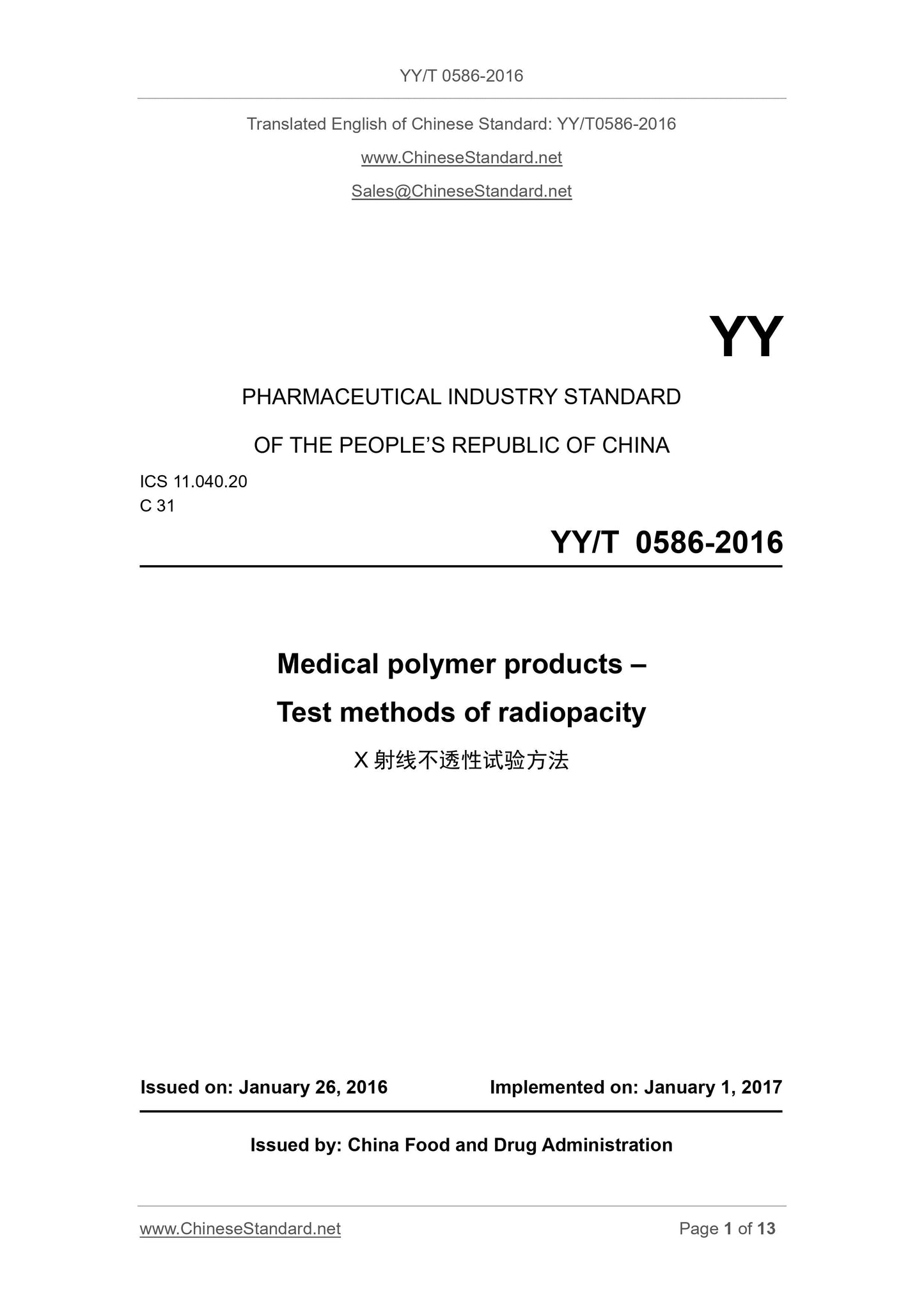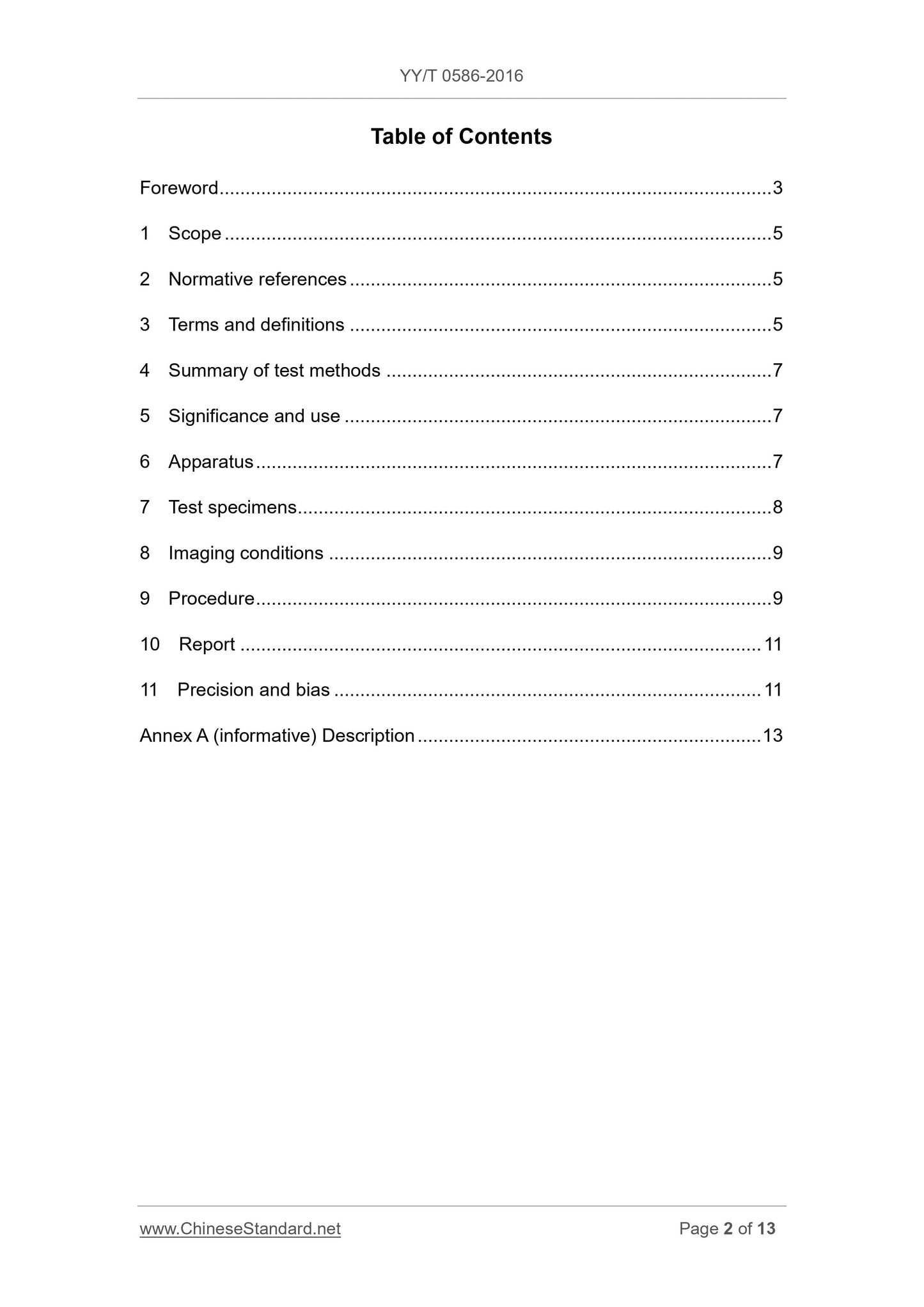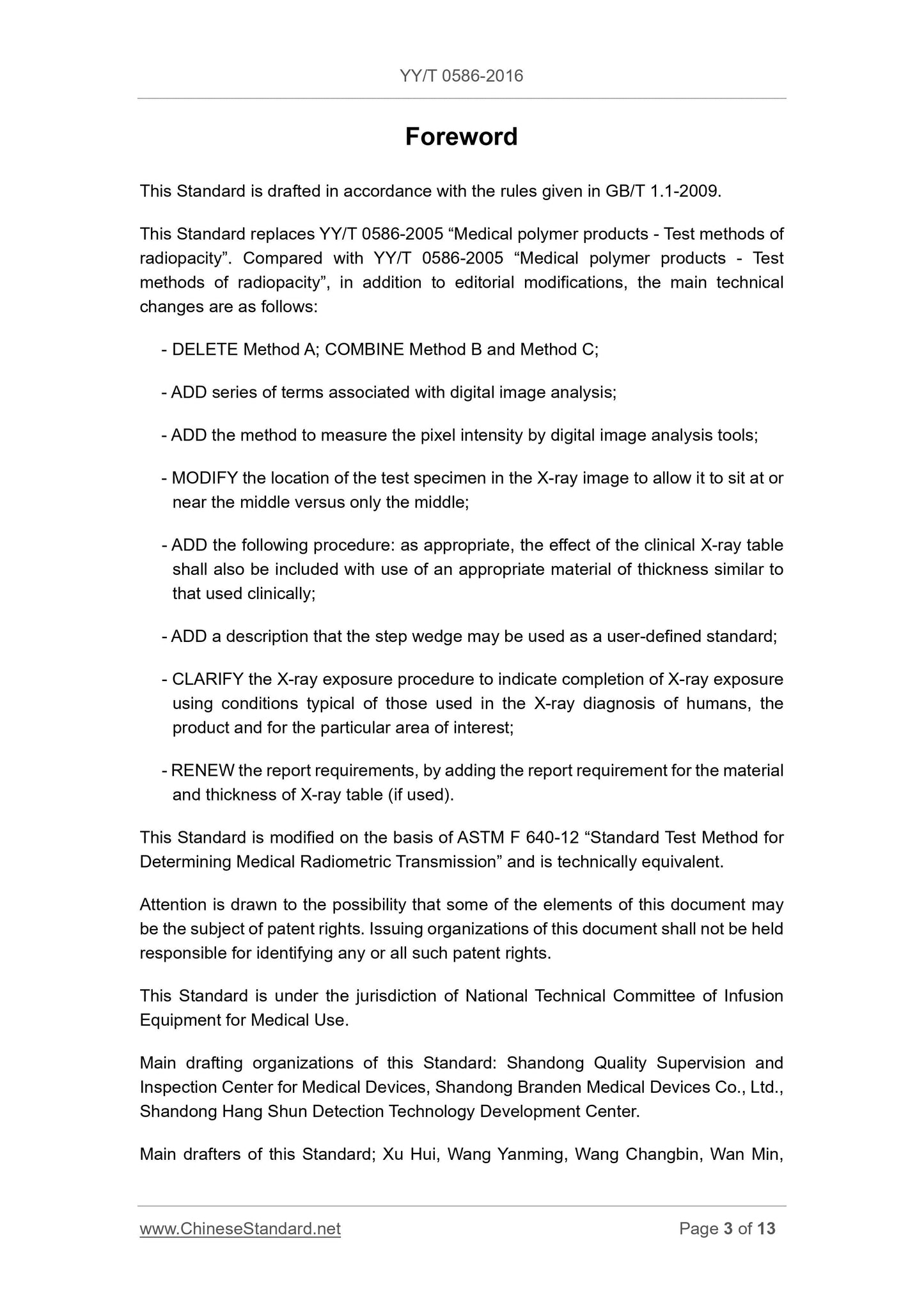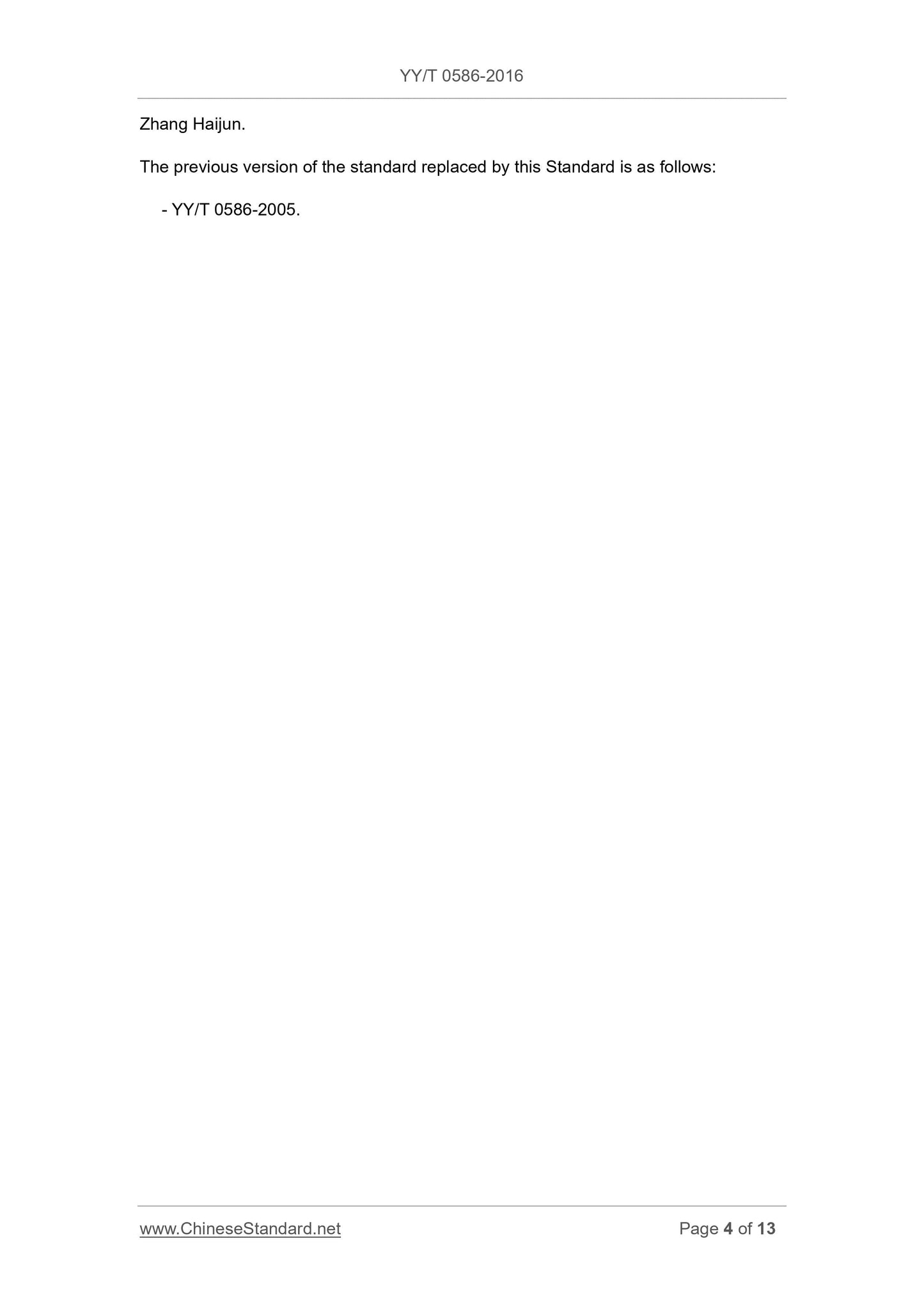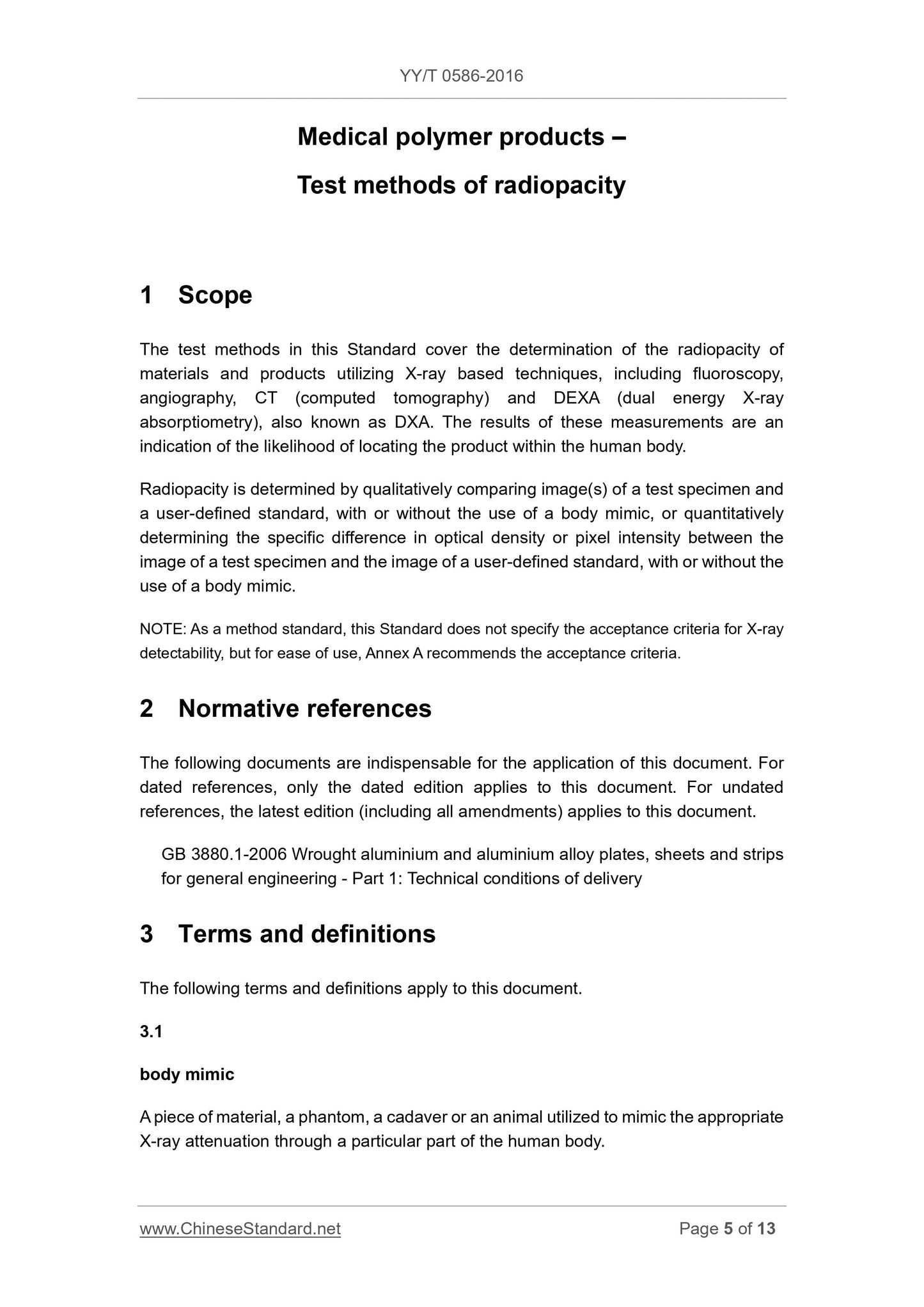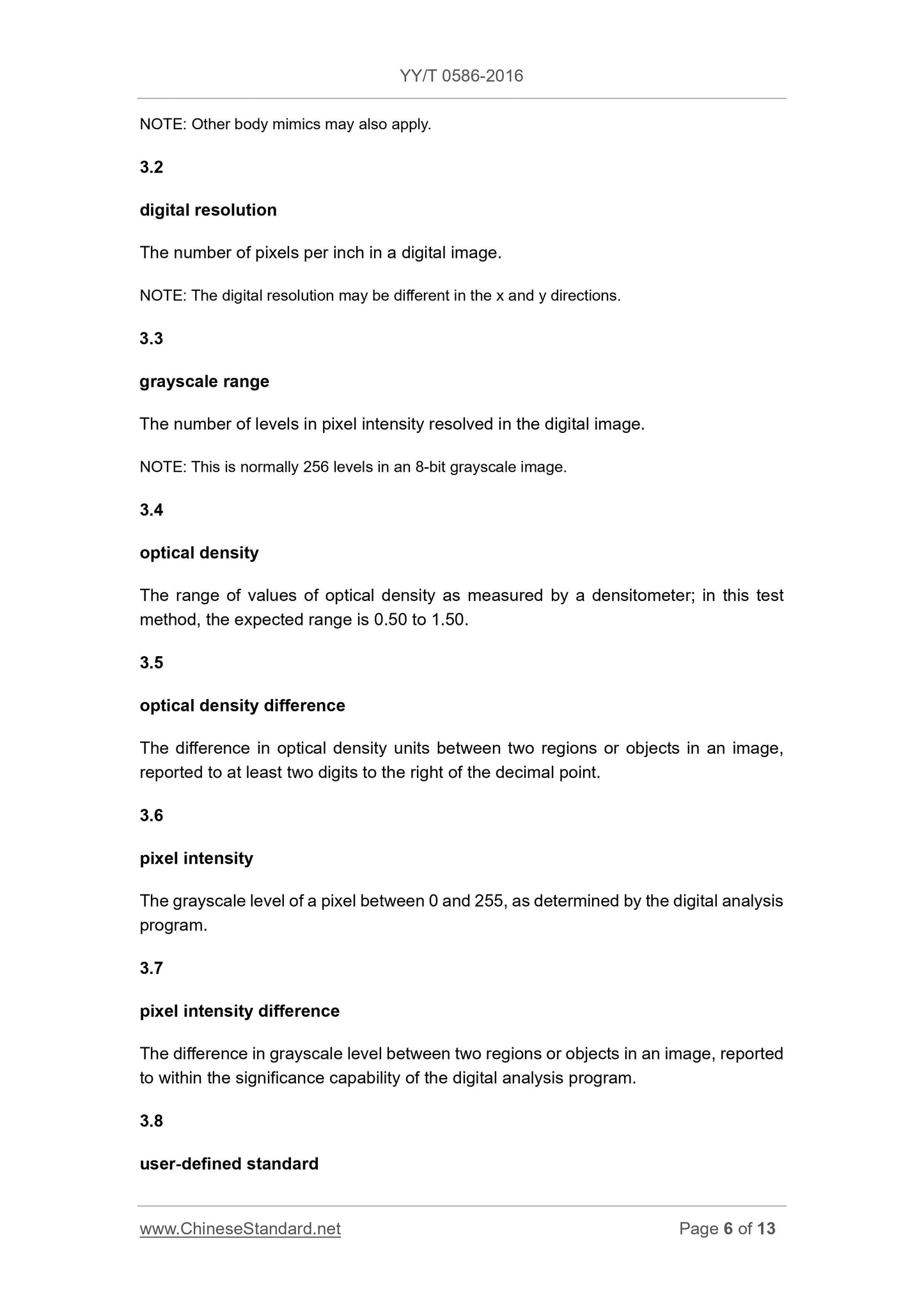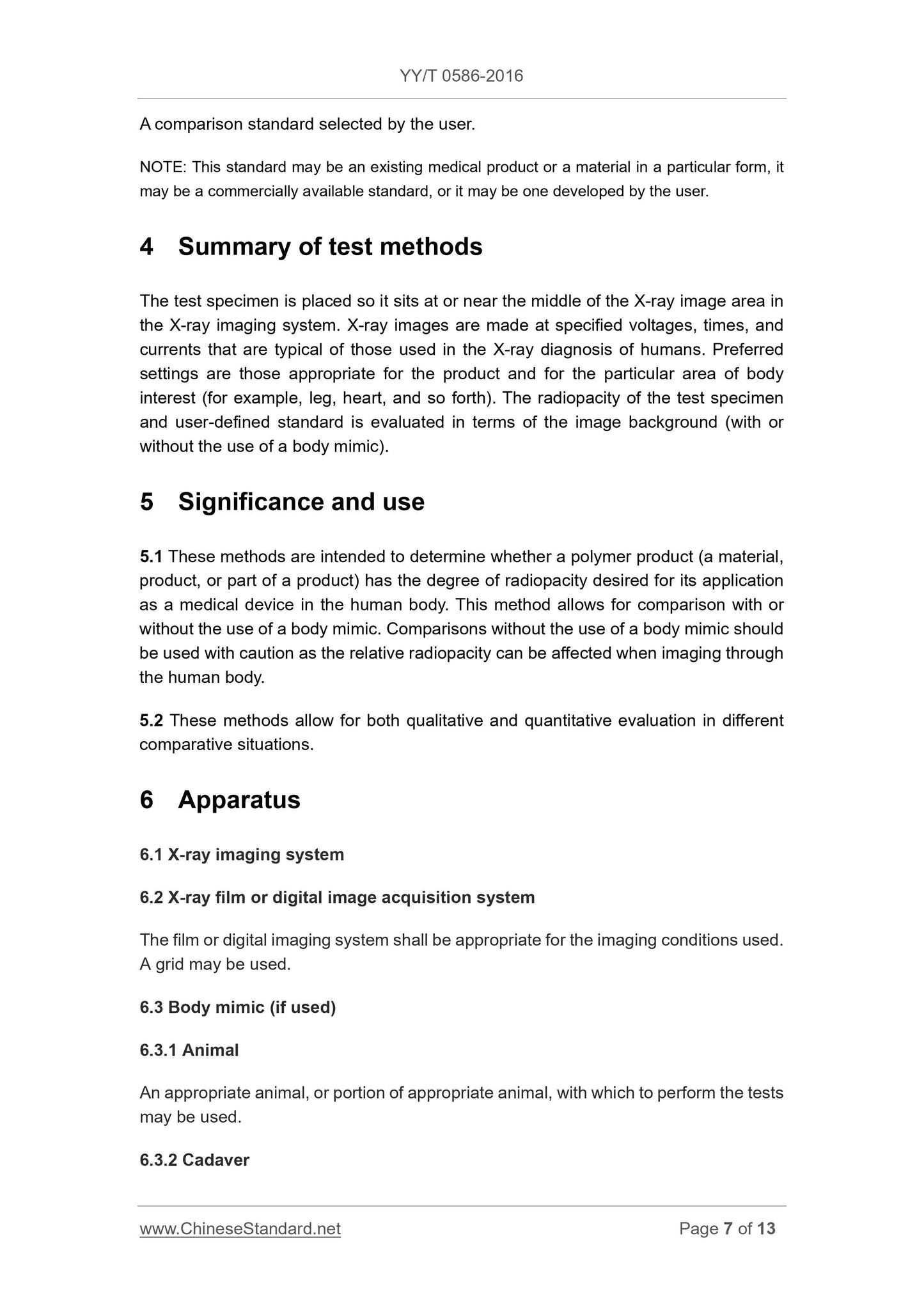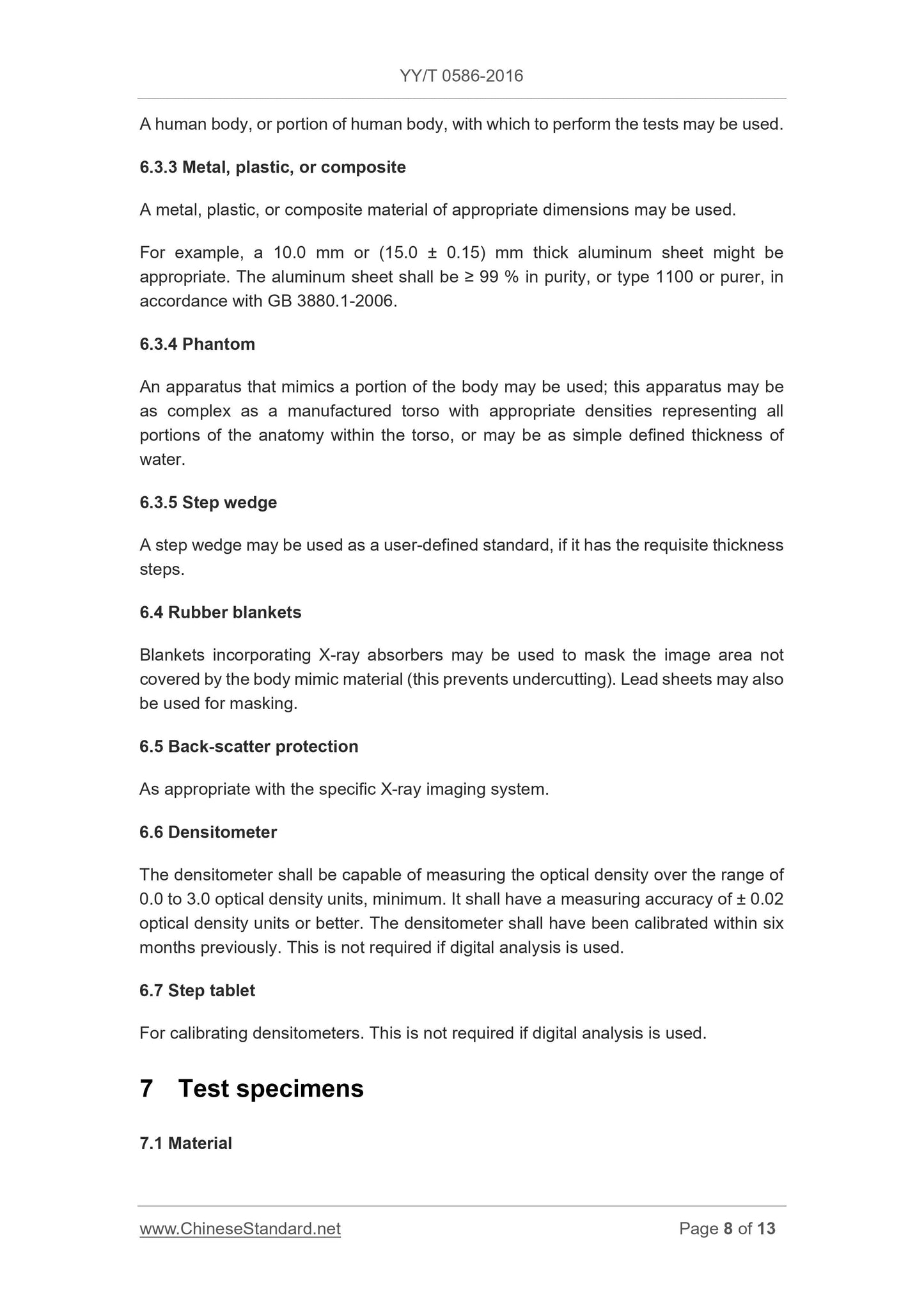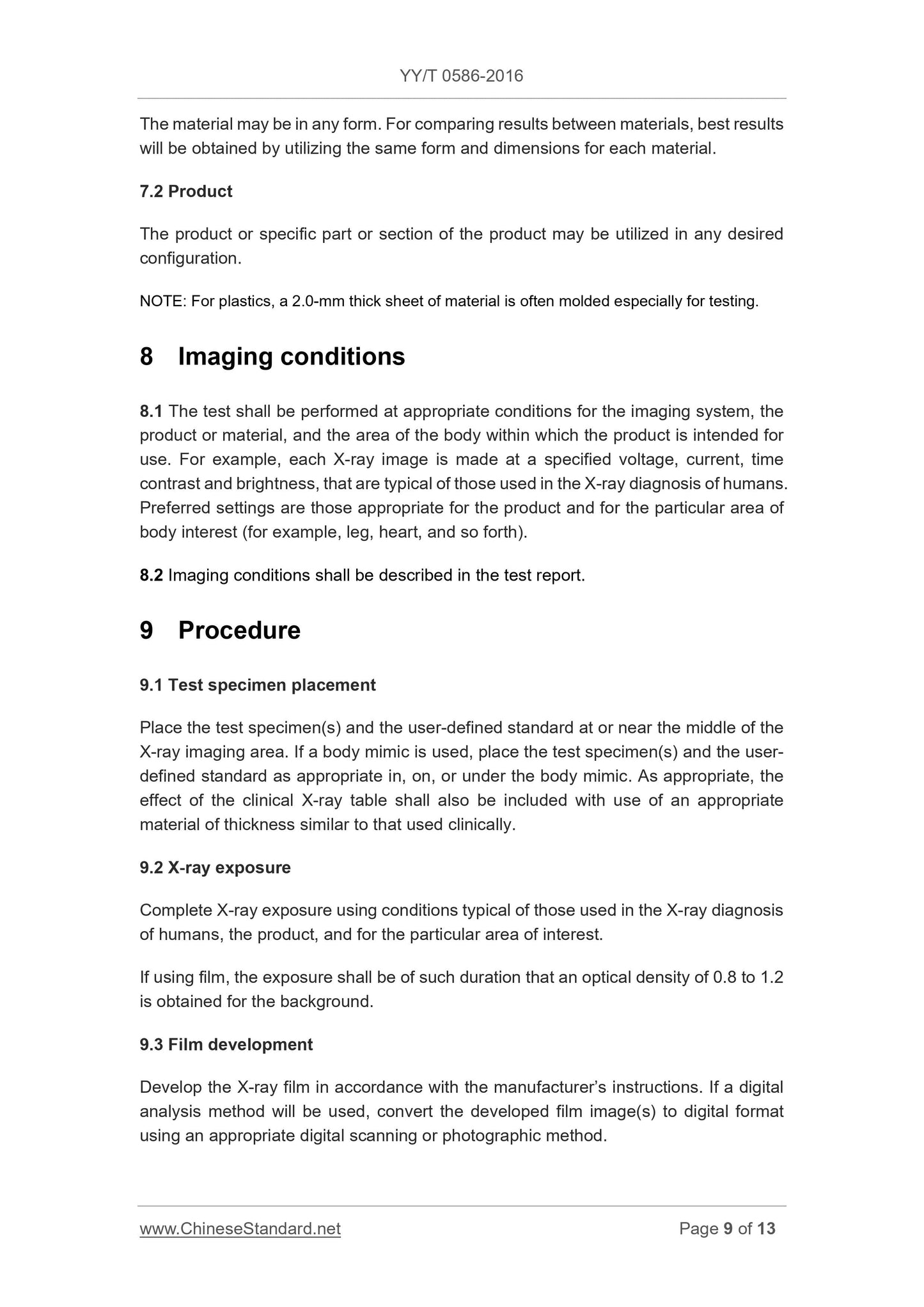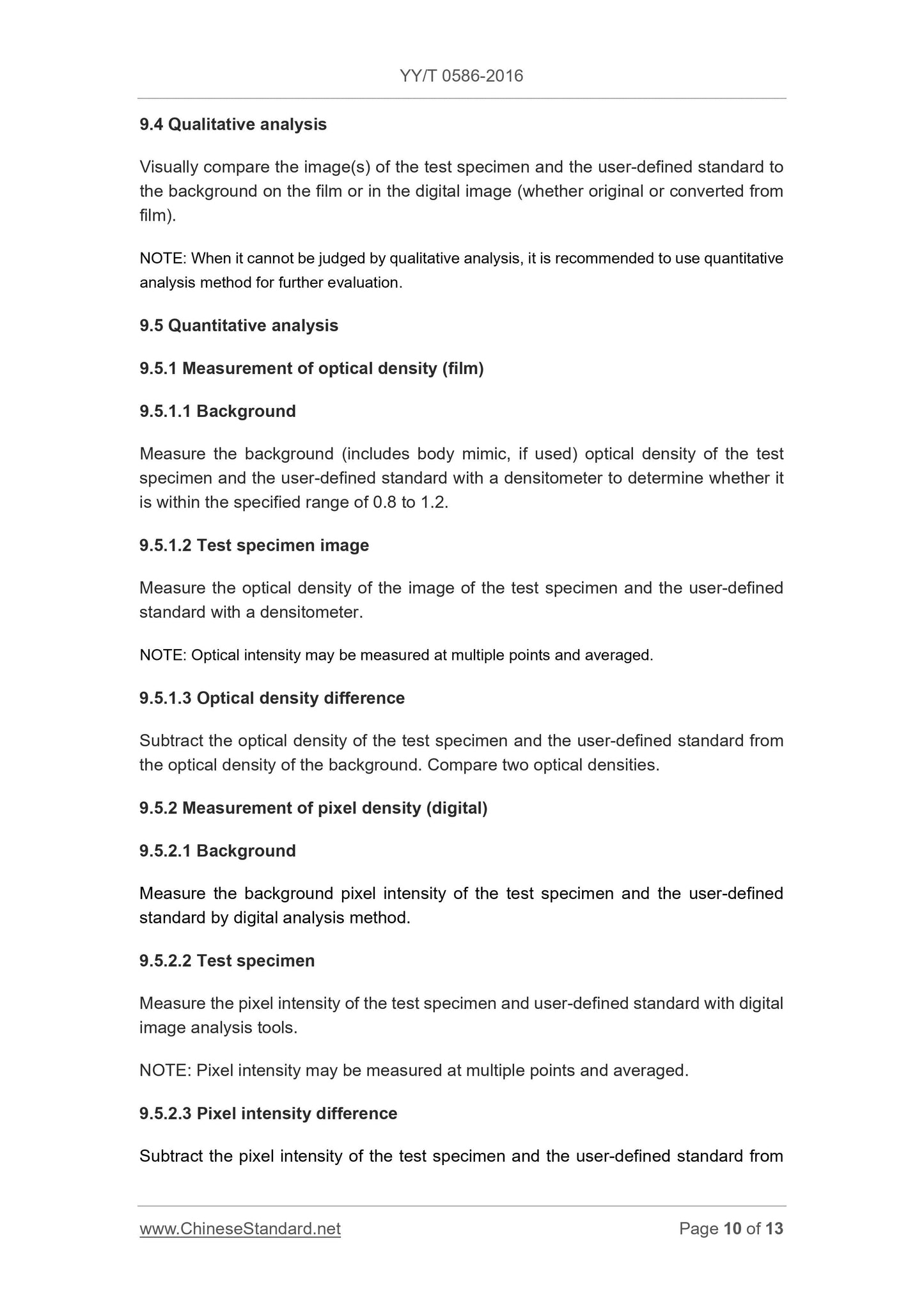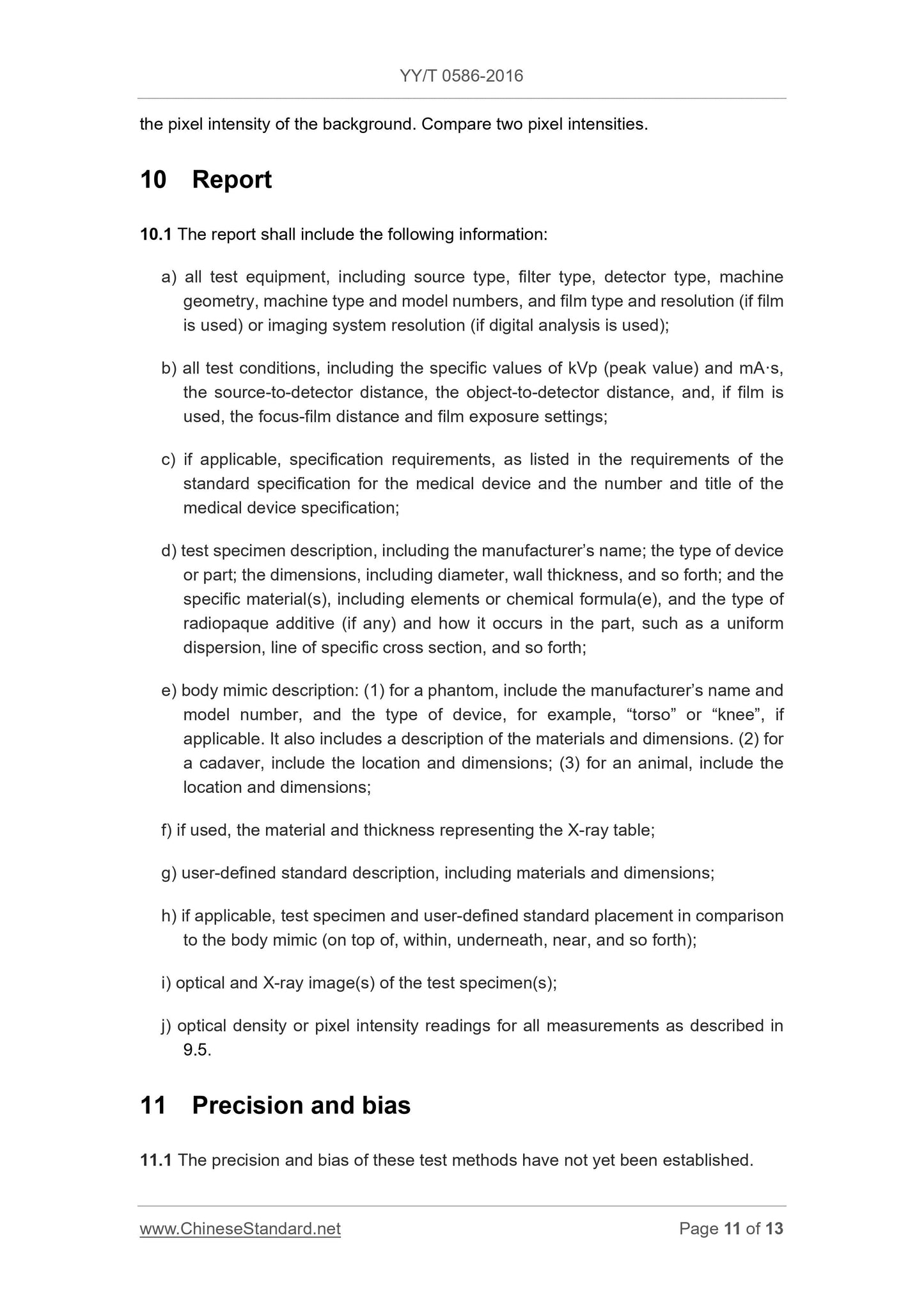1
/
of
12
www.ChineseStandard.us -- Field Test Asia Pte. Ltd.
YY/T 0586-2016 English PDF (YY/T0586-2016)
YY/T 0586-2016 English PDF (YY/T0586-2016)
Regular price
$85.00
Regular price
Sale price
$85.00
Unit price
/
per
Shipping calculated at checkout.
Couldn't load pickup availability
YY/T 0586-2016: Medical polymer products - Test methods of radiopacity
Delivery: 9 seconds. Download (& Email) true-PDF + Invoice.
Get Quotation: Click YY/T 0586-2016 (Self-service in 1-minute)
Historical versions (Master-website): YY/T 0586-2016
Preview True-PDF (Reload/Scroll-down if blank)
YY/T 0586-2016
YY
PHARMACEUTICAL INDUSTRY STANDARD
OF THE PEOPLE’S REPUBLIC OF CHINA
ICS 11.040.20
C 31
Medical polymer products –
Test methods of radiopacity
ISSUED ON. JANUARY 26, 2016
IMPLEMENTED ON. JANUARY 1, 2017
Issued by. China Food and Drug Administration
Table of Contents
Foreword ... 3
1 Scope ... 5
2 Normative references ... 5
3 Terms and definitions ... 5
4 Summary of test methods ... 7
5 Significance and use ... 7
6 Apparatus ... 7
7 Test specimens ... 8
8 Imaging conditions ... 9
9 Procedure ... 9
10 Report ... 11
11 Precision and bias ... 11
Annex A (informative) Description ... 13
Foreword
This Standard is drafted in accordance with the rules given in GB/T 1.1-2009.
This Standard replaces YY/T 0586-2005 “Medical polymer products - Test methods of
radiopacity”. Compared with YY/T 0586-2005 “Medical polymer products - Test
methods of radiopacity”, in addition to editorial modifications, the main technical
changes are as follows.
- DELETE Method A; COMBINE Method B and Method C;
- ADD series of terms associated with digital image analysis;
- ADD the method to measure the pixel intensity by digital image analysis tools;
- MODIFY the location of the test specimen in the X-ray image to allow it to sit at or
near the middle versus only the middle;
- ADD the following procedure. as appropriate, the effect of the clinical X-ray table
shall also be included with use of an appropriate material of thickness similar to
that used clinically;
- ADD a description that the step wedge may be used as a user-defined standard;
- CLARIFY the X-ray exposure procedure to indicate completion of X-ray exposure
using conditions typical of those used in the X-ray diagnosis of humans, the
product and for the particular area of interest;
- RENEW the report requirements, by adding the report requirement for the material
and thickness of X-ray table (if used).
This Standard is modified on the basis of ASTM F 640-12 “Standard Test Method for
Determining Medical Radiometric Transmission” and is technically equivalent.
Attention is drawn to the possibility that some of the elements of this document may
be the subject of patent rights. Issuing organizations of this document shall not be held
responsible for identifying any or all such patent rights.
This Standard is under the jurisdiction of National Technical Committee of Infusion
Equipment for Medical Use.
Main drafting organizations of this Standard. Shandong Quality Supervision and
Inspection Center for Medical Devices, Shandong Branden Medical Devices Co., Ltd.,
Shandong Hang Shun Detection Technology Development Center.
Main drafters of this Standard; Xu Hui, Wang Yanming, Wang Changbin, Wan Min,
Medical polymer products –
Test methods of radiopacity
1 Scope
The test methods in this Standard cover the determination of the radiopacity of
materials and products utilizing X-ray based techniques, including fluoroscopy,
angiography, CT (computed tomography) and DEXA (dual energy X-ray
absorptiometry), also known as DXA. The results of these measurements are an
indication of the likelihood of locating the product within the human body.
Radiopacity is determined by qualitatively comparing image(s) of a test specimen and
a user-defined standard, with or without the use of a body mimic, or quantitatively
determining the specific difference in optical density or pixel intensity between the
image of a test specimen and the image of a user-defined standard, with or without the
use of a body mimic.
NOTE. As a method standard, this Standard does not specify the acceptance criteria for X-ray
detectability, but for ease of use, Annex A recommends the acceptance criteria.
2 Normative references
The following documents are indispensable for the application of this document. For
dated references, only the dated edition applies to this document. For undated
references, the latest edition (including all amendments) applies to this document.
GB 3880.1-2006 Wrought aluminium and aluminium alloy plates, sheets and strips
for general engineering - Part 1. Technical conditions of delivery
3 Terms and definitions
The following terms and definitions apply to this document.
3.1
body mimic
A piece of material, a phantom, a cadaver or an animal utilized to mimic the appropriate
X-ray attenuation through a particular part of the human body.
A comparison standard selected by the user.
NOTE. This standard may be an existing medical product or a material in a particular form, it
may be a commercially available standard, or it may be one developed by the user.
4 Summary of test methods
The test specimen is placed so it sits at or near the middle of the X-ray image area in
the X-ray imaging system. X-ray images are made at specified voltages, times, and
currents that are typical of those used in the X-ray diagnosis of humans. Preferred
settings are those appropriate for the product and for the particular area of body
interest (for example, leg, heart, and so forth). The radiopacity of the test specimen
and user-defined standard is evaluated in terms of the image background (with or
without the use of a body mimic).
5 Significance and use
5.1 These methods are intended to determine whether a polymer product (a material,
product, or part of a product) has the degree of radiopacity desired for its application
as a medical device in the human body. This method allows for comparison with or
without the use of a body mimic. Comparisons without the use of a body mimic should
be used with caution as the relative radiopacity can be affected when imaging through
the human body.
5.2 These methods allow for both qualitative and quantitative evaluation in different
comparative situations.
6 Apparatus
6.1 X-ray imaging system
6.2 X-ray film or digital image acquisition system
The film or digital imaging system shall be appropriate for the imaging conditions used.
A grid may be used.
6.3 Body mimic (if used)
6.3.1 Animal
An appropriate animal, or portion of appropriate animal, with which to perform the tests
may be used.
6.3.2 Cadaver
The material may be in any form. For comparing results between materials, best results
will be obtained by utilizing the same form and dimensions for each material.
7.2 Product
The product or specific part or section of the product may be utilized in any desired
configuration.
NOTE. For plastics, a 2.0-mm thick sheet of material is often molded especially for testing.
8 Imaging conditions
8.1 The test shall be performed at appropriate conditions for the imaging system, the
product or material, and the area of the body within which the product is intended for
use. For example, each X-ray image is made at a specified voltage, current, time
contrast and brightness, that are typical of those used in the X-ray diagnosis of humans.
Preferred settings are those appropriate for the product and for the particular area of
body interest (for example, leg, heart, and so forth).
8.2 Imaging conditions shall be described in the test report.
9 Procedure
9.1 Test specimen placement
Place the test specimen(s) and the user-defined standard at or near the middle of the
X-ray imaging area. If a body mimic is used, place the test specimen(s) and the user-
defined standard as appropriate in, on, or under the body mimic. As appropriate, the
effect of the clinical X-ray table shall also be included with use of an appropriate
material of thickness similar to that used clinically.
9.2 X-ray exposure
Complete X-ray exposure using conditions typical of those used in the X-ray diagnosis
of humans, the product, and for the particular area of interest.
If using film, the exposure shall be of such duration that an optical density of 0.8 to 1.2
is obtained for the background.
9.3 Film development
Develop the X-ray film in accordance with the manufacturer’s instructions. If a digital
analysis method will be used, convert the developed film image(s) to digital format
using an appropriate digital scanning or photographic method.
the pixel intensity of the background. Compare two pixel intensities.
10 Report
10.1 The report shall include the following information.
a) all test equipment, including source type, filter type, detector type, machine
geometry, machine type and model numbers, and film type and resolution (if film
is used) or imaging system resolution (if digital analysis is used);
b) all test conditions, including the specific values of kVp (peak value) and mA·s,
the source-to-detector distance, the object-to-detector distance, and, if film is
used, the focus-film distance and film exposure settings;
c) if applica...
YY/T 0586-2016
YY
PHARMACEUTICAL INDUSTRY STANDARD
OF THE PEOPLE’S REPUBLIC OF CHINA
ICS 11.040.20
C 31
Medical polymer products –
Test methods of radiopacity
ISSUED ON. JANUARY 26, 2016
IMPLEMENTED ON. JANUARY 1, 2017
Issued by. China Food and Drug Administration
Table of Contents
Foreword ... 3
1 Scope ... 5
2 Normative references ... 5
3 Terms and definitions ... 5
4 Summary of test methods ... 7
5 Significance and use ... 7
6 Apparatus ... 7
7 Test specimens ... 8
8 Imaging conditions ... 9
9 Procedure ... 9
10 Report ... 11
11 Precision and bias ... 11
Annex A (informative) Description ... 13
Foreword
This Standard is drafted in accordance with the rules given in GB/T 1.1-2009.
This Standard replaces YY/T 0586-2005 “Medical polymer products - Test methods of
radiopacity”. Compared with YY/T 0586-2005 “Medical polymer products - Test
methods of radiopacity”, in addition to editorial modifications, the main technical
changes are as follows.
- DELETE Method A; COMBINE Method B and Method C;
- ADD series of terms associated with digital image analysis;
- ADD the method to measure the pixel intensity by digital image analysis tools;
- MODIFY the location of the test specimen in the X-ray image to allow it to sit at or
near the middle versus only the middle;
- ADD the following procedure. as appropriate, the effect of the clinical X-ray table
shall also be included with use of an appropriate material of thickness similar to
that used clinically;
- ADD a description that the step wedge may be used as a user-defined standard;
- CLARIFY the X-ray exposure procedure to indicate completion of X-ray exposure
using conditions typical of those used in the X-ray diagnosis of humans, the
product and for the particular area of interest;
- RENEW the report requirements, by adding the report requirement for the material
and thickness of X-ray table (if used).
This Standard is modified on the basis of ASTM F 640-12 “Standard Test Method for
Determining Medical Radiometric Transmission” and is technically equivalent.
Attention is drawn to the possibility that some of the elements of this document may
be the subject of patent rights. Issuing organizations of this document shall not be held
responsible for identifying any or all such patent rights.
This Standard is under the jurisdiction of National Technical Committee of Infusion
Equipment for Medical Use.
Main drafting organizations of this Standard. Shandong Quality Supervision and
Inspection Center for Medical Devices, Shandong Branden Medical Devices Co., Ltd.,
Shandong Hang Shun Detection Technology Development Center.
Main drafters of this Standard; Xu Hui, Wang Yanming, Wang Changbin, Wan Min,
Medical polymer products –
Test methods of radiopacity
1 Scope
The test methods in this Standard cover the determination of the radiopacity of
materials and products utilizing X-ray based techniques, including fluoroscopy,
angiography, CT (computed tomography) and DEXA (dual energy X-ray
absorptiometry), also known as DXA. The results of these measurements are an
indication of the likelihood of locating the product within the human body.
Radiopacity is determined by qualitatively comparing image(s) of a test specimen and
a user-defined standard, with or without the use of a body mimic, or quantitatively
determining the specific difference in optical density or pixel intensity between the
image of a test specimen and the image of a user-defined standard, with or without the
use of a body mimic.
NOTE. As a method standard, this Standard does not specify the acceptance criteria for X-ray
detectability, but for ease of use, Annex A recommends the acceptance criteria.
2 Normative references
The following documents are indispensable for the application of this document. For
dated references, only the dated edition applies to this document. For undated
references, the latest edition (including all amendments) applies to this document.
GB 3880.1-2006 Wrought aluminium and aluminium alloy plates, sheets and strips
for general engineering - Part 1. Technical conditions of delivery
3 Terms and definitions
The following terms and definitions apply to this document.
3.1
body mimic
A piece of material, a phantom, a cadaver or an animal utilized to mimic the appropriate
X-ray attenuation through a particular part of the human body.
A comparison standard selected by the user.
NOTE. This standard may be an existing medical product or a material in a particular form, it
may be a commercially available standard, or it may be one developed by the user.
4 Summary of test methods
The test specimen is placed so it sits at or near the middle of the X-ray image area in
the X-ray imaging system. X-ray images are made at specified voltages, times, and
currents that are typical of those used in the X-ray diagnosis of humans. Preferred
settings are those appropriate for the product and for the particular area of body
interest (for example, leg, heart, and so forth). The radiopacity of the test specimen
and user-defined standard is evaluated in terms of the image background (with or
without the use of a body mimic).
5 Significance and use
5.1 These methods are intended to determine whether a ...
Delivery: 9 seconds. Download (& Email) true-PDF + Invoice.
Get Quotation: Click YY/T 0586-2016 (Self-service in 1-minute)
Historical versions (Master-website): YY/T 0586-2016
Preview True-PDF (Reload/Scroll-down if blank)
YY/T 0586-2016
YY
PHARMACEUTICAL INDUSTRY STANDARD
OF THE PEOPLE’S REPUBLIC OF CHINA
ICS 11.040.20
C 31
Medical polymer products –
Test methods of radiopacity
ISSUED ON. JANUARY 26, 2016
IMPLEMENTED ON. JANUARY 1, 2017
Issued by. China Food and Drug Administration
Table of Contents
Foreword ... 3
1 Scope ... 5
2 Normative references ... 5
3 Terms and definitions ... 5
4 Summary of test methods ... 7
5 Significance and use ... 7
6 Apparatus ... 7
7 Test specimens ... 8
8 Imaging conditions ... 9
9 Procedure ... 9
10 Report ... 11
11 Precision and bias ... 11
Annex A (informative) Description ... 13
Foreword
This Standard is drafted in accordance with the rules given in GB/T 1.1-2009.
This Standard replaces YY/T 0586-2005 “Medical polymer products - Test methods of
radiopacity”. Compared with YY/T 0586-2005 “Medical polymer products - Test
methods of radiopacity”, in addition to editorial modifications, the main technical
changes are as follows.
- DELETE Method A; COMBINE Method B and Method C;
- ADD series of terms associated with digital image analysis;
- ADD the method to measure the pixel intensity by digital image analysis tools;
- MODIFY the location of the test specimen in the X-ray image to allow it to sit at or
near the middle versus only the middle;
- ADD the following procedure. as appropriate, the effect of the clinical X-ray table
shall also be included with use of an appropriate material of thickness similar to
that used clinically;
- ADD a description that the step wedge may be used as a user-defined standard;
- CLARIFY the X-ray exposure procedure to indicate completion of X-ray exposure
using conditions typical of those used in the X-ray diagnosis of humans, the
product and for the particular area of interest;
- RENEW the report requirements, by adding the report requirement for the material
and thickness of X-ray table (if used).
This Standard is modified on the basis of ASTM F 640-12 “Standard Test Method for
Determining Medical Radiometric Transmission” and is technically equivalent.
Attention is drawn to the possibility that some of the elements of this document may
be the subject of patent rights. Issuing organizations of this document shall not be held
responsible for identifying any or all such patent rights.
This Standard is under the jurisdiction of National Technical Committee of Infusion
Equipment for Medical Use.
Main drafting organizations of this Standard. Shandong Quality Supervision and
Inspection Center for Medical Devices, Shandong Branden Medical Devices Co., Ltd.,
Shandong Hang Shun Detection Technology Development Center.
Main drafters of this Standard; Xu Hui, Wang Yanming, Wang Changbin, Wan Min,
Medical polymer products –
Test methods of radiopacity
1 Scope
The test methods in this Standard cover the determination of the radiopacity of
materials and products utilizing X-ray based techniques, including fluoroscopy,
angiography, CT (computed tomography) and DEXA (dual energy X-ray
absorptiometry), also known as DXA. The results of these measurements are an
indication of the likelihood of locating the product within the human body.
Radiopacity is determined by qualitatively comparing image(s) of a test specimen and
a user-defined standard, with or without the use of a body mimic, or quantitatively
determining the specific difference in optical density or pixel intensity between the
image of a test specimen and the image of a user-defined standard, with or without the
use of a body mimic.
NOTE. As a method standard, this Standard does not specify the acceptance criteria for X-ray
detectability, but for ease of use, Annex A recommends the acceptance criteria.
2 Normative references
The following documents are indispensable for the application of this document. For
dated references, only the dated edition applies to this document. For undated
references, the latest edition (including all amendments) applies to this document.
GB 3880.1-2006 Wrought aluminium and aluminium alloy plates, sheets and strips
for general engineering - Part 1. Technical conditions of delivery
3 Terms and definitions
The following terms and definitions apply to this document.
3.1
body mimic
A piece of material, a phantom, a cadaver or an animal utilized to mimic the appropriate
X-ray attenuation through a particular part of the human body.
A comparison standard selected by the user.
NOTE. This standard may be an existing medical product or a material in a particular form, it
may be a commercially available standard, or it may be one developed by the user.
4 Summary of test methods
The test specimen is placed so it sits at or near the middle of the X-ray image area in
the X-ray imaging system. X-ray images are made at specified voltages, times, and
currents that are typical of those used in the X-ray diagnosis of humans. Preferred
settings are those appropriate for the product and for the particular area of body
interest (for example, leg, heart, and so forth). The radiopacity of the test specimen
and user-defined standard is evaluated in terms of the image background (with or
without the use of a body mimic).
5 Significance and use
5.1 These methods are intended to determine whether a polymer product (a material,
product, or part of a product) has the degree of radiopacity desired for its application
as a medical device in the human body. This method allows for comparison with or
without the use of a body mimic. Comparisons without the use of a body mimic should
be used with caution as the relative radiopacity can be affected when imaging through
the human body.
5.2 These methods allow for both qualitative and quantitative evaluation in different
comparative situations.
6 Apparatus
6.1 X-ray imaging system
6.2 X-ray film or digital image acquisition system
The film or digital imaging system shall be appropriate for the imaging conditions used.
A grid may be used.
6.3 Body mimic (if used)
6.3.1 Animal
An appropriate animal, or portion of appropriate animal, with which to perform the tests
may be used.
6.3.2 Cadaver
The material may be in any form. For comparing results between materials, best results
will be obtained by utilizing the same form and dimensions for each material.
7.2 Product
The product or specific part or section of the product may be utilized in any desired
configuration.
NOTE. For plastics, a 2.0-mm thick sheet of material is often molded especially for testing.
8 Imaging conditions
8.1 The test shall be performed at appropriate conditions for the imaging system, the
product or material, and the area of the body within which the product is intended for
use. For example, each X-ray image is made at a specified voltage, current, time
contrast and brightness, that are typical of those used in the X-ray diagnosis of humans.
Preferred settings are those appropriate for the product and for the particular area of
body interest (for example, leg, heart, and so forth).
8.2 Imaging conditions shall be described in the test report.
9 Procedure
9.1 Test specimen placement
Place the test specimen(s) and the user-defined standard at or near the middle of the
X-ray imaging area. If a body mimic is used, place the test specimen(s) and the user-
defined standard as appropriate in, on, or under the body mimic. As appropriate, the
effect of the clinical X-ray table shall also be included with use of an appropriate
material of thickness similar to that used clinically.
9.2 X-ray exposure
Complete X-ray exposure using conditions typical of those used in the X-ray diagnosis
of humans, the product, and for the particular area of interest.
If using film, the exposure shall be of such duration that an optical density of 0.8 to 1.2
is obtained for the background.
9.3 Film development
Develop the X-ray film in accordance with the manufacturer’s instructions. If a digital
analysis method will be used, convert the developed film image(s) to digital format
using an appropriate digital scanning or photographic method.
the pixel intensity of the background. Compare two pixel intensities.
10 Report
10.1 The report shall include the following information.
a) all test equipment, including source type, filter type, detector type, machine
geometry, machine type and model numbers, and film type and resolution (if film
is used) or imaging system resolution (if digital analysis is used);
b) all test conditions, including the specific values of kVp (peak value) and mA·s,
the source-to-detector distance, the object-to-detector distance, and, if film is
used, the focus-film distance and film exposure settings;
c) if applica...
YY/T 0586-2016
YY
PHARMACEUTICAL INDUSTRY STANDARD
OF THE PEOPLE’S REPUBLIC OF CHINA
ICS 11.040.20
C 31
Medical polymer products –
Test methods of radiopacity
ISSUED ON. JANUARY 26, 2016
IMPLEMENTED ON. JANUARY 1, 2017
Issued by. China Food and Drug Administration
Table of Contents
Foreword ... 3
1 Scope ... 5
2 Normative references ... 5
3 Terms and definitions ... 5
4 Summary of test methods ... 7
5 Significance and use ... 7
6 Apparatus ... 7
7 Test specimens ... 8
8 Imaging conditions ... 9
9 Procedure ... 9
10 Report ... 11
11 Precision and bias ... 11
Annex A (informative) Description ... 13
Foreword
This Standard is drafted in accordance with the rules given in GB/T 1.1-2009.
This Standard replaces YY/T 0586-2005 “Medical polymer products - Test methods of
radiopacity”. Compared with YY/T 0586-2005 “Medical polymer products - Test
methods of radiopacity”, in addition to editorial modifications, the main technical
changes are as follows.
- DELETE Method A; COMBINE Method B and Method C;
- ADD series of terms associated with digital image analysis;
- ADD the method to measure the pixel intensity by digital image analysis tools;
- MODIFY the location of the test specimen in the X-ray image to allow it to sit at or
near the middle versus only the middle;
- ADD the following procedure. as appropriate, the effect of the clinical X-ray table
shall also be included with use of an appropriate material of thickness similar to
that used clinically;
- ADD a description that the step wedge may be used as a user-defined standard;
- CLARIFY the X-ray exposure procedure to indicate completion of X-ray exposure
using conditions typical of those used in the X-ray diagnosis of humans, the
product and for the particular area of interest;
- RENEW the report requirements, by adding the report requirement for the material
and thickness of X-ray table (if used).
This Standard is modified on the basis of ASTM F 640-12 “Standard Test Method for
Determining Medical Radiometric Transmission” and is technically equivalent.
Attention is drawn to the possibility that some of the elements of this document may
be the subject of patent rights. Issuing organizations of this document shall not be held
responsible for identifying any or all such patent rights.
This Standard is under the jurisdiction of National Technical Committee of Infusion
Equipment for Medical Use.
Main drafting organizations of this Standard. Shandong Quality Supervision and
Inspection Center for Medical Devices, Shandong Branden Medical Devices Co., Ltd.,
Shandong Hang Shun Detection Technology Development Center.
Main drafters of this Standard; Xu Hui, Wang Yanming, Wang Changbin, Wan Min,
Medical polymer products –
Test methods of radiopacity
1 Scope
The test methods in this Standard cover the determination of the radiopacity of
materials and products utilizing X-ray based techniques, including fluoroscopy,
angiography, CT (computed tomography) and DEXA (dual energy X-ray
absorptiometry), also known as DXA. The results of these measurements are an
indication of the likelihood of locating the product within the human body.
Radiopacity is determined by qualitatively comparing image(s) of a test specimen and
a user-defined standard, with or without the use of a body mimic, or quantitatively
determining the specific difference in optical density or pixel intensity between the
image of a test specimen and the image of a user-defined standard, with or without the
use of a body mimic.
NOTE. As a method standard, this Standard does not specify the acceptance criteria for X-ray
detectability, but for ease of use, Annex A recommends the acceptance criteria.
2 Normative references
The following documents are indispensable for the application of this document. For
dated references, only the dated edition applies to this document. For undated
references, the latest edition (including all amendments) applies to this document.
GB 3880.1-2006 Wrought aluminium and aluminium alloy plates, sheets and strips
for general engineering - Part 1. Technical conditions of delivery
3 Terms and definitions
The following terms and definitions apply to this document.
3.1
body mimic
A piece of material, a phantom, a cadaver or an animal utilized to mimic the appropriate
X-ray attenuation through a particular part of the human body.
A comparison standard selected by the user.
NOTE. This standard may be an existing medical product or a material in a particular form, it
may be a commercially available standard, or it may be one developed by the user.
4 Summary of test methods
The test specimen is placed so it sits at or near the middle of the X-ray image area in
the X-ray imaging system. X-ray images are made at specified voltages, times, and
currents that are typical of those used in the X-ray diagnosis of humans. Preferred
settings are those appropriate for the product and for the particular area of body
interest (for example, leg, heart, and so forth). The radiopacity of the test specimen
and user-defined standard is evaluated in terms of the image background (with or
without the use of a body mimic).
5 Significance and use
5.1 These methods are intended to determine whether a ...
Share
